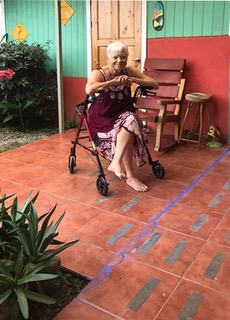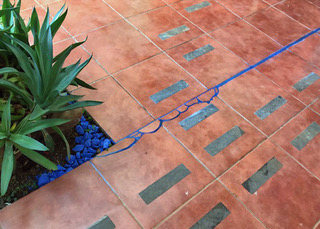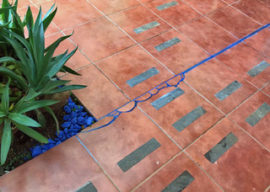
Jan finished katsugi
My house, Casa de Corazon sits high above the city of San Isidro de El General with a magnificent view over the city and the mountains beyond. One can almost see Panama from my place. The formal (if such a word could or should be used) entry to my house is through a front metal gate and along an 80 ft. long ceramic tile walkway. Contiguous with the walkway are two level ceramic tiled porches – one in front of Casa Tranquila which was to be Frank’s house and the other in front of my house. I selected ceramic tile for lots of reasons – and it is the Costa Rican material of choice – indoors as well as outdoors.
The tropical weather is hard on outdoor ceramic tiles that have to endure the average 16.5 ft of rain/year. While the tile is hit hard, the grout between the tiles often suffers first and most noticeably. If it isn’t the ‘over 300 earth quakes/year’ it is drenching rain followed by dry periods that shrink the soils and start the cracks.
Still I hardly noticed the first crack.
In the early months of 2020, after my diagnosis of Leukemia, I started using my walker for exercise. It was and is hard for me to walk. My routine was back and forth on the ceramic walkway and it wasn’t long until I began counting my steps. At the beginning I could walk only about 40 steps before my upper legs and buttocks cramped and I was forced to rest for awhile. But very soon after I was trying for 45 steps…
I was on a mission. Every day pushing myself to walk a few steps more than the day before.
Somewhere around 200 steps/day I noticed that the cracked ceramic tiles along the grout line were needing attention. And soon after I noticed a couple of chips that broke off the adjacent concrete tiles. They varied from small fingernail sized chips to a couple that were nearly the length of my hand. The broken pieces laid in the uneven grout-less slot between Casa de Tranquila’s ‘porch’ and the long walkway.
Each time I walked while counting my steps, I found my eyes lingering on what was becoming a prominent focus of the not pleasant type. All along my route there were no other chipped edges. Just this one, about 1 ½ ft. long. By the time I reached 250 steps/day I knew I had to do something about it. It wasn’t just an eyesore anymore. Manuevering around it to make the necessary U-turn wasn’t easy and it was getting worse.

Jan and Oscar making a plan
I began to consider my repair options and found that there were no easy or inexpensive ones. We (builder, tile-setter and neighbor Oscar) and I had no extra matching tiles. Nor did the tile places in town. Without matching tiles we would have to make due with an ‘almost matching’ tile and that just didn’t sit well in my artist or architectural brain. We could take out and replace a single long line of tiles that extended from the carport to the Studio Rancho steps – about 80 ft. But what color or pattern would work so that it didn’t simply look like a 80 ft. long mistake? My artist’s mind splayed out a circular array of possible hues that resembled ‘the wheel of fortune’… and no good solution came to mind.
Meanwhile, I kept walking step by step and counting….
One day at around my 320 steps/day mark I remembered reading about an intriguing Japaneze art called Kintsugi or ‘the art of Precious Scars” https://www.lifegate.com/people/lifestyle/kintsugi
The kintsugi method was to repair broken pieces of pottery using lacquered resin and powdered gold. The repaired pottery was transformed into more of a jewel. I wondered if I could repair my broken tiles in a similar way. Not with gold, but….. I continued thinking as I walked….
I’m not sure when the plan settled into my mind, but when it finally took hold I decided to talk with Oscar about it. Oscar’s answer to most any question I had about building was “No problem Jan”. And it was the only English he spoke. Between his Tico good naturedness and resourcefulness and my Architecture/Art trained eyes and imagination, we always found a solution using communication through my limited Spanish and sketches.
My idea was to transform the broken area into an abstract art rendition of a river with stones in it using a kintsugi-like tradition of repair. We would use the chipped pieces of ceramic tile as the stones and a blue colored grout as the river water. The reflective surface of the water would hopefully be accomplished with a little varnish. The tricky part was creating the stones. We could not use the existing ships as puzzle pieces because we wanted space between for the “water”. Oscar brought up his grinder and listened patiently as I tried to explain things like river currents rounding the edges of the stones and maintaining the horizontality of the stone edges that were next to the intact tiles. And the impromptu morning that we talked about it suddenly morphed into the morning we did it. That was the Tico way. We began with me, seated in my walker and Oscar on hands and knees with paper and a marker. I would sketch the shape for the next stone and then duplicate the sketch onto the piece of tile followed by Oscar grinding the tile edges to match. Back and forth from the carport to the project. ‘Poquito menos aqui” or “a little less here” and ‘poco a poco’. I’m pretty sure there are tools like tracing paper and better markers tucked away somewhere in my studio but we used what we had on hand and right in the current moment.

Timoteo Canal
The finishing part included the need (in my mind) for the river to have an origin as well as a destination. I decided the origin would be at the beginning of the tile next to the car port which meant removing an entire line of grout along the side of Casa Tranquila and replacing it with the blue. And what about the river destination? One of my sons suggested an idea, in jest – that the dirt surrounding an agave like plant at the juncture of the walk and the porch becomes a reservoir. So I promptly named it Tim Lagoon and had Oscar place some leftover hardened paint chips there – they were at least the right color. I told Tim that when and if he ever gets to come to Costa Rica again to visit he had better bring some tiny boats for his lagoon.
I’m al little sad that what I had originally imagined as a metaphoric/philosophical response using the kantsugi technique turned out in the end to be slightly cartoonish. Still, it occupied much of what could have been routine and repetitive time and gave me much to think about as I walked.
By the time I got to 550 steps I began wondering what the next project would be. I still am.


